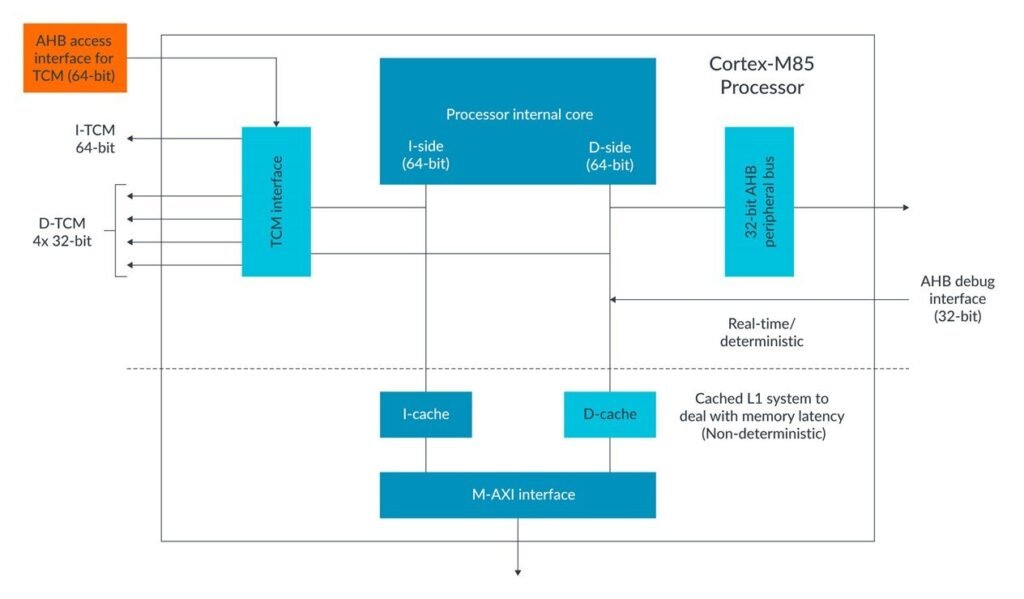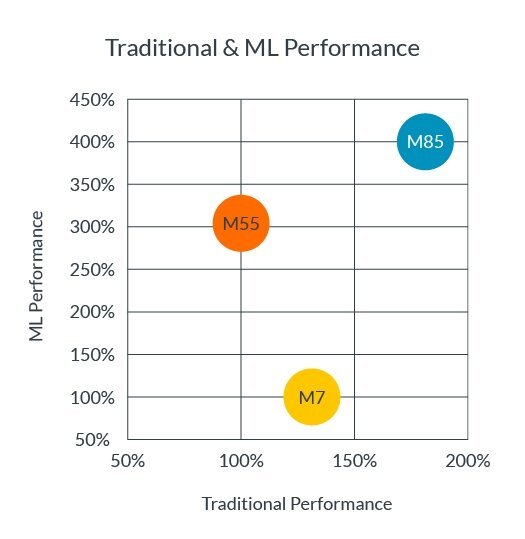The ARM Cortex-M85 is the latest and most advanced microcontroller CPU core in ARM’s Cortex-M series. It provides significantly higher performance and efficiency compared to previous Cortex-M cores, making it suitable for more demanding embedded and IoT applications.
Overview
As with other Cortex-M cores, the M85 is a 32-bit RISC processor optimized for embedded applications requiring a balance of high performance, low power consumption, and small silicon footprint. Key features include:
- Up to 1 GHz clock frequency
- 5-stage pipeline
- Out-of-order dual-issue superscalar design
- Advanced branch prediction and prefetch
- Optional configurable cache
- Floating point unit (FPU)
- Advanced debug capabilities
- Memory protection unit (MPU)
- TrustZone security extension

The M85 microarchitecture incorporates multiple innovations to boost performance compared to prior Cortex-M cores like the M7 and M33. This includes deeper pipelining, dual-issue superscalar execution, and out-of-order completion. The core can issue up to two instructions per cycle to the execute stage, helping increase instruction throughput and efficiency.
To feed the dual-issue pipeline, the M85 employs advanced branch prediction with a 512-entry branch target buffer, along with prefetch buffers to reduce stalls. The core also benefits from a configurable level 1 or level 2 cache to optimize memory access latency and bandwidth.

For workloads involving significant floating point math, the optional single or double precision FPU further accelerates performance. The FPU pipeline is also superscalar and out-of-order for high throughput.
Performance and Efficiency
In terms of raw performance, the Cortex-M85 achieves up to 5 CoreMark/MHz, a commonly used benchmark for measuring embedded processor performance. This is over 3x higher than the Cortex-M7 and a 5-10x gain over earlier Cortex-M cores.
Along with higher performance, the M85 also delivers greater energy efficiency thanks to its advanced microarchitecture. ARM claims it provides up to 40% better energy efficiency compared to prior cores for a given workload. This enables more work to be done for a given power budget.
The M85 is fabricated on the latest semiconductor processes down to 5nm. The smaller geometry and FinFET transistors contribute to the improved power and area efficiency.
Use Cases
The increased capabilities of the Cortex-M85 allow it to meet the needs of increasingly complex embedded applications, particularly in segments such as:
- Industrial automation
- Robotics
- Digital signal processing
- Computer vision
- Machine learning
- Autonomous vehicles
- 5G infrastructure
For products that require both real-time responsiveness and high-performance parallel processing, the M85 delivers both without compromising energy efficiency. This includes applications using AI at the edge.
The M85’s high level of integration also helps reduce system complexity and BOM cost. With on-chip memory, cache, and rich peripherals, less external components are required to build a complete system.
Software and Tools
To enable software development, the Cortex-M85 is supported by ARM’s Mbed OS, FreeRTOS, Zephyr RTOS, and other real-time operating systems. All code written for previous Cortex-M cores will run on the M85, providing easy software migration.
ARM’s suite of tools is also available, including the compiler, debugger, and Cortex Microcontroller Software Interface Standard (M-SIS). This helps accelerate development and debugging.
For designing an M85 system-on-chip, ARM provides the CoreLink mesh fabric and various peripheral IP blocks. Combined with Artisan physical libraries, full system integration is enabled using industry-standard flows.
Licensing and Availability
Like other ARM CPU cores, the Cortex-M85 is available for licensing to semiconductor companies and SoC designers. It builds on ARM’s extensive experience licensing IP cores for ASIC and SoC implementation.
The M85 allows ample time for chip vendors to design it into their roadmaps. Given the strong industry momentum behind the Internet of Things and edge computing, the M85 arrives at an opportune time to power the next generation of embedded products and applications.

